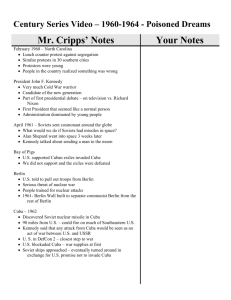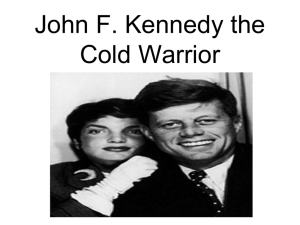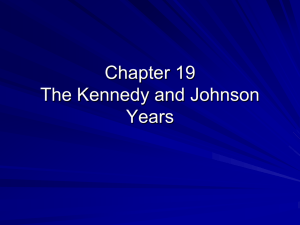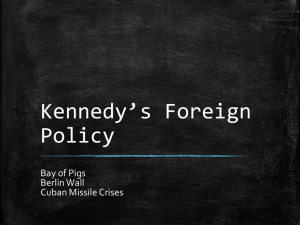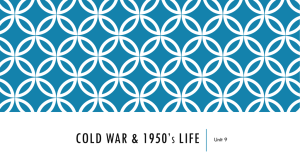Cuba - Mrs. Thomas
advertisement
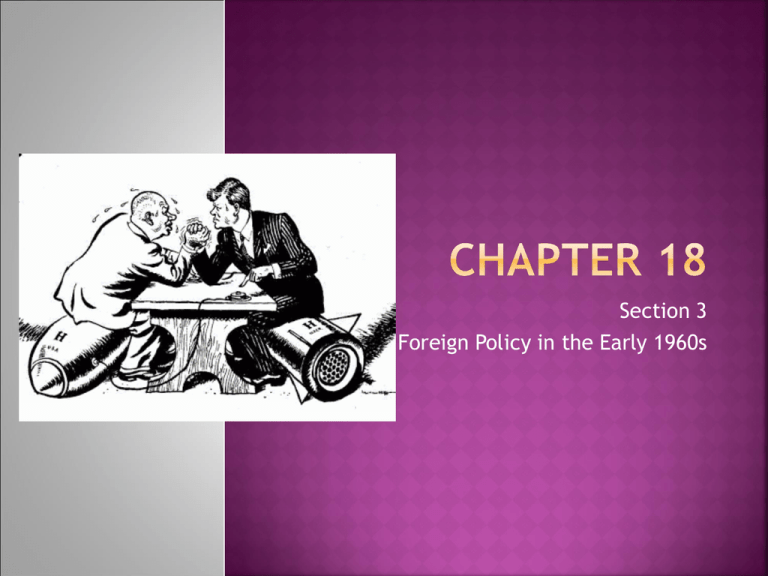
Section 3 Foreign Policy in the Early 1960s Think about how the United States purses relationships with other countries. Create a list of what you think should be our foreign policy goals. The failed invasion of Cuba by a group of Anti-Castro forces In 1961. Barrier built by the East German government in 1961, to prevent East Germans from escaping to West Berlin. 1962 crisis that arose between the United States and the Soviet Union over a Soviet attempt to deploy nuclear missiles in Cuba. Treaty signed in 1963, in which the US and Soviet Union agreed not to test nuclear weapons above ground. President Kennedy's proposal for cooperation among nations of the Western Hemisphere to meet the basic needs of people. Federal program established to send volunteers to help developing nations around the world. President Kennedy acted boldly in response to a series of dramatic cold war crises in Cuba and Berlin. Johnson continued many of Kennedy’s foreign policies. “Let every nation know, whether it wishes us well or ill, that we shall pay any price, bear any burden, meet any hardship, support any friend, oppose any foe to assure the survival and the success of liberty”. John F. Kennedy, Inaugural Address Bay of Pigs Invasion The US backed dictator Fulgencio Batista was overthrown by revolutionary Fidel Castro in 1959 America broke off diplomatic relations with Cuba after Castro seized American owned property in Cuba. Cuba began to develop relations with the Soviet Union The US feared that this would bring rebellion throughout Latin America. Under Eisenhower, the CIA planned to train Cuban opponents of Castro in Guatemala. After the training was complete, they would invade Cuba and overthrow Castro. Although Kennedy faced resistance about the mission, he decided to go ahead and in 1961 they invasion took place. The (5:35 minutes) Invasion United States participation in the invasion was exposed to the world Latin American countries were angered that the US violated non-interference agreements European leaders were concerned about Kennedy’s leadership Construction of the Berlin Wall After WWII, Germany was divided among the United States, Great Britain, France, and the Soviet Union. The capital city of Berlin was divided as well. West Berlin (West Germany) was controlled by the Allies: US, Britain, and France East Berlin (East Germany) was controlled by the Soviets. The Soviets failed to cut off access to Berlin in 1948 (Berlin Airlift prevented it). In 1961, Soviets demanded a treaty that would permanently divide the city. Kennedy met with Nikita Khrushchev in Vienna, Austria to discuss the proposal. The Soviets made a public ultimatum and Kennedy felt bullied. Kennedy increased defense spending, the number of men drafted and built fallout shelters across the country in case of nuclear war. To build the Berlin Wall in August 1961. Construction (2:23 minutes) The Cuban Missile Crisis October 16, 1962, an American spy plane photographed the Soviets building missile bases on Cuba. Although this didn’t change the nuclear threat as the Soviets could already bomb the US, Kennedy needed to respond. Kennedy ordered the US forces at full alert. Bombers and missiles were armed with nuclear weapons. The fleet was ready to move. Soldiers were prepared to invade Cuba. Kennedy addressed the nation and told the Soviets to remove the missiles form Cuba. He authorized a naval “quarantine” around Cuba The purpose was to stop the Soviets from bringing more missiles to Cuba. Timeline of events October 24, 1962 - the “quarantine” went into effect. October 25, 1962 - a Soviet ship crossed the line. It was only an oil tanker and was allowed to proceed. Several other Soviet ships were heading to Cuba, but suddenly turned back. October 26, 1962 – Khrushchev sent a letter to Kennedy asking him to end the quarantine. If he did, the Soviets would remove their missiles. October 27, 1962 – Khrushchev sent a second letter to Kennedy demanding the US to remove its missiles from Turkey in exchange for the removal of Soviet missiles from Cuba. The US accepted the terms of the first letter and ignored the second. The two countries were never so close to nuclear war and haven’t been that close since. On the Brink of Nuclear War (5:30 minutes) Outcomes: A “hot line” was established between the two countries so that they could discuss issues at a moment’s notice. The Limited Test Ban Treaty was signed in the summer of 1963, which eliminated above ground testing of nuclear weapons. Kennedy’s Plan It included cooperation among nations of the Western Hemisphere to meet the basic needs of people: shelter, work, land, health, and schools. To encourage developing nations to ally themselves with the democratic countries of the West. He pledged $20 billion to support the work of the Alliance. Latin countries believed he was simply trying to stop the spread of communism and therefore it didn’t live up to expectations. Established in 1961 Federal program established to send volunteers to help developing nations around the world. They work as educators, health workers, and technicians. When Johnson became President, he had his own foreign policy problems. They included threats of the spread of communism in Latin America and Asia. The Dominican Republic The island was attacked by rebels. Johnson believed Communists were the cause. He sent 22,000 marines to the island Their presence tipped the balance away from the rebels. The provisional government backed by the US was installed and elections were held the next year. Vietnam There was an on-going conflict in Southeast Asia between the Communistic North Vietnam and nonCommunist South Vietnam. By 1963, 16,000 military advisors were already in South Vietnam. The US was providing aid to them as well. In the 1964 election, Johnson opposed more direct involvement. By 1965, he could no longer wait and the US became more involved in propping up the South Vietnamese government with troops and money.
